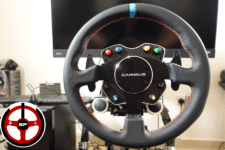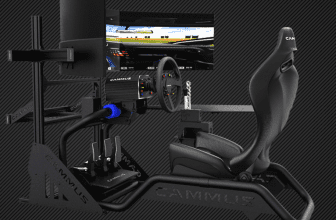The Cammus DDWB 2021 is a fairly straightforward offering: 15Nm, 500€. That’s it. It’s big and it’s cheap. With this very first model, released two years ago, the Chinese brand was looking to make its mark in the world of Sim Racing by playing the very aggressive price card.
But what does this base model actually achieve? We’ll find out. One thing’s for sure, reader, Flo and I were very surprised that Cammus themselves asked us to write this review. It’s no secret to any brand that we don’t hesitate to bring out the artillery when necessary. When I asked Cammus if they were aware that we were really going to give our clear opinion on the model, they nodded in agreement and told us that “it’s precisely because they’re looking for concrete feedback that they can improve their range”.
So I’d like to salute this brand’s fair play. Having said that, let’s get on with the test!
What does the Cammus DDWB 2021 look like technically?

| Compatibility | PC |
| Dimensions | 33cm long including QR, 14cm high and 19.5cm wide |
| Motor | Direct Drive (stepper motor) |
| Torque | Peak: 15Nm Continuous: Not communicated Reactivity (torque rise) : Not communicated |
| Encoder | Not communicated |
| Turning range | 180° to 2520° adjustable via Thrustmaster software |
| Connections | 1 USB output to PC 1 power supply 7 CAN bus ports for Thrustmaster accessories 1 port for connecting an emergency stop button |
| Wheel mounting | NRG-type Quick Release |
Design and ergonomics
When you first discover the Cammus DDWB, you have to admit that its size is impressive. It’s the most voluminous base on the SimRacing market in this order of power.
On the other hand, I was immediately pleasantly surprised by the finish of the material. The base is in black aluminum and the corners have attractive aluminum-colored chamfers.
On the front of the base you’ll find the ignition button, as well as 5 buttons , 2 rotary selectors and 2 switches. We’ll be able to set them in our games. It’s a nice idea, but we’ll have to see how practical it is for racing.
- In the box:
- Cammus DDWBbase
- Steering wheel (rim, hub, quick release, emblem and screws for self-mounting)
- NRG-typequick release
- 1power supply unit
- 1 USB-C – USB cable
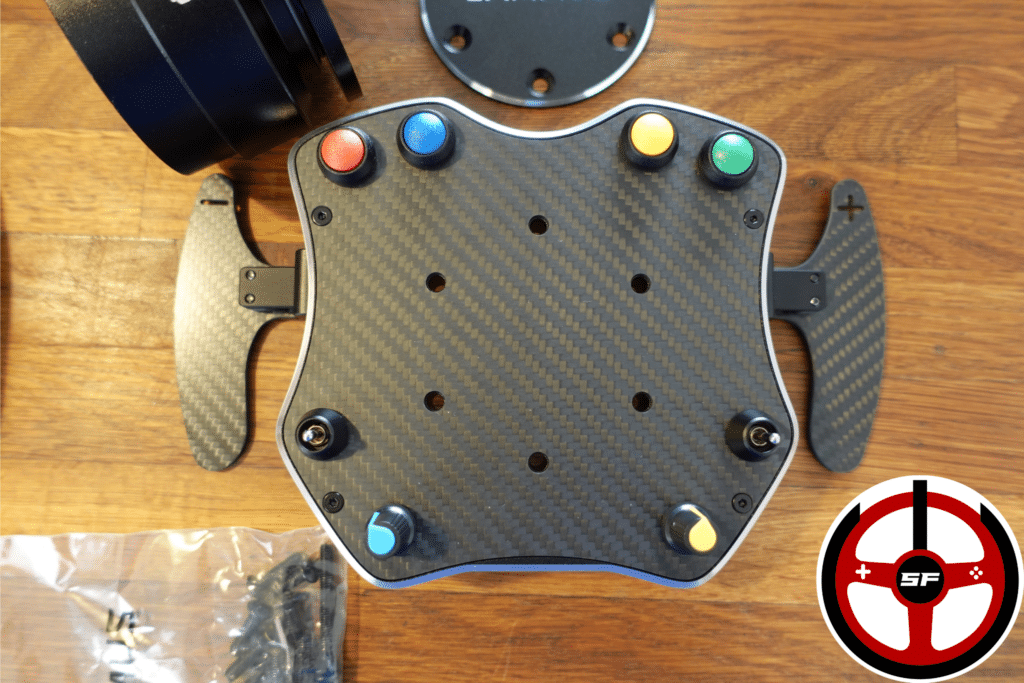
The steering wheel , too, is a pleasant surprise: the faux-leather wheel with its aluminum and carbon hub is attractive, and once fitted is rigid and pleasant to hold. The paddles are magnetic and can be adjusted to suit the length of your fingers. In concrete terms, these aspects are way above what I expected.
Buttons of discord
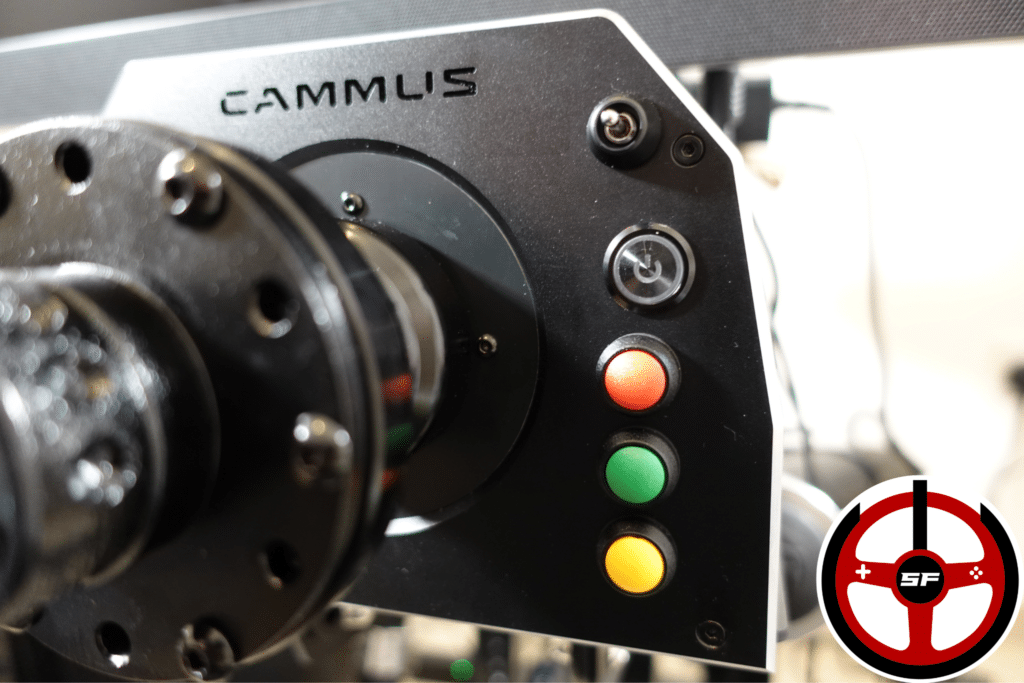
However, things start to go wrong as soon as you press the buttons for the first time. The buttons chosen by Cammus are both very soft and have no “click” at all, so there’s no feeling when you reach the end. And their garish colors really stand out from the rest of the finish.
The buttons are backlit, although they only light up when you press them… so you never see their light! The same goes for the rotary selectors, which are very soft when turned and not at all precise.
Moving on to the rear of the base
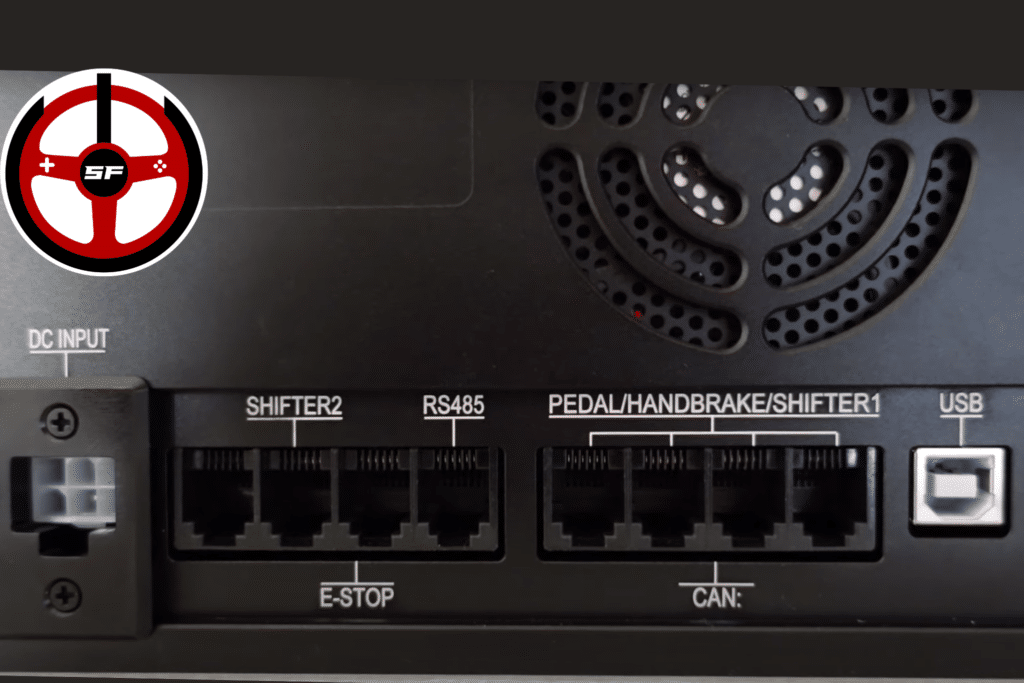
At the rear of the base, we find all the sockets for connecting our Cammus ecosystem. But also the fan grill, which is there to cool the base’s PCB.
Yes, unlike most Direct Drives, which are nowadays passively cooled or managed by software, here there’s a fan for the card. And we’ll see how useful it is during testing!
A quick look at assembly
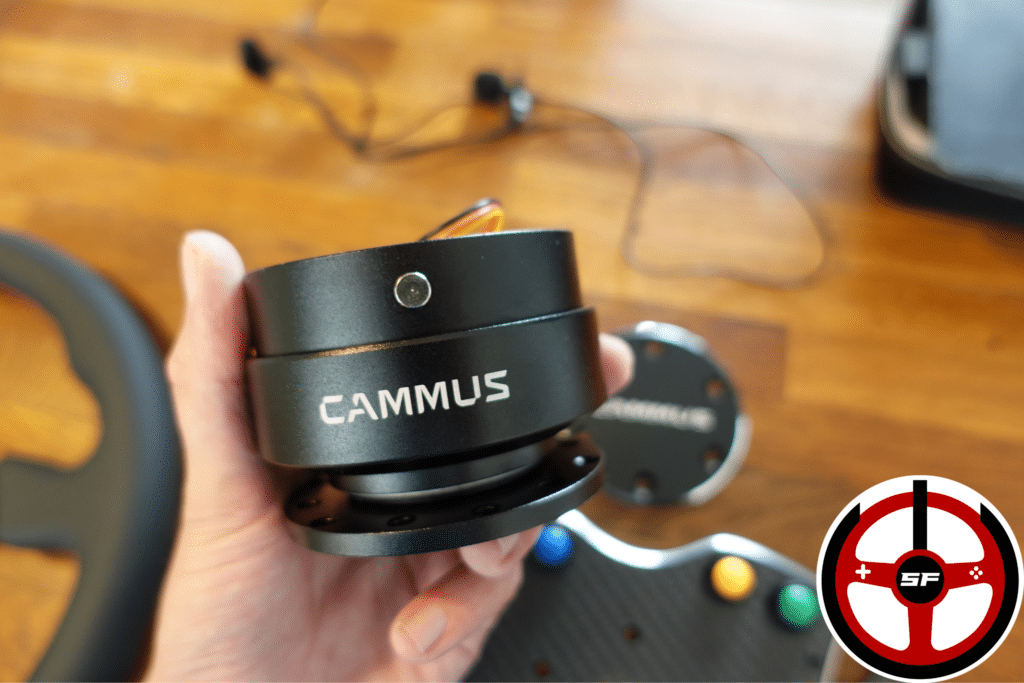
The bundle we received includes a GT steering wheel and the base itself. But before you can drive it, you’ll have to do a little DIY.
Nothing too major, just mount the Hub and QR on the steering wheel rim, then install the male part of the Quick Release on the steering shaft. All this while taking care to connect the small plugs that will enable the base to communicate with the steering wheel. The operation takes roughly 10 minutes.
Installing the Cammus DDWB on the chassis
Now that the parts are assembled, I’m going to install the base on my chassis. Bad luck, in my case I won’t be able to “easily” screw the 4 screws under the base, as my chassis doesn’t have the corresponding holes.
Take the time to check whether you’ll need to drill or not! In my case, I was able to get by with an adapter supplied by another brand, which “did the job”. Otherwise I would have had to drill.
- Mounting options:
- 4 M6 screw threads (center distance 93mm wide x 95mm long)
- 1 rail on each side of the base for sliding T-nuts.
- 1 tilting adapter bracket (optional)
Cammus Quick Release
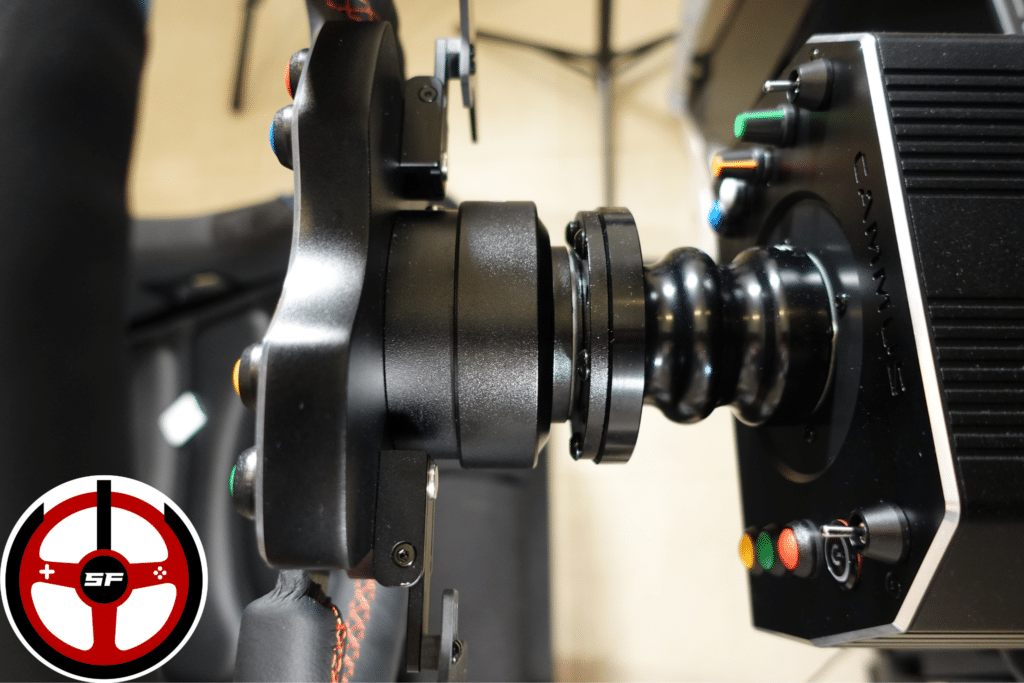
Unsurprisingly, this Cammus DDWB features an NRG-type Quick Release system. You’d think all Chinese companies had the same supplier. But we can’t complain, as this is an extremely high-performance model that leaves no play between the steering wheel and the steering shaft.
The only minor improvement I would make on this model would be to remove the safety button. Having to press the button while pulling on the ring to remove the steering wheel isn’t very practical. But at least the QR does its job, and once again, at this price, I wouldn’t ask for anything more.
Software settings
With the PC ready, the base connected and switched on, it’s time to get down to settings! And here again I was pleasantly surprised. Cammus’ software is simple and comprehensive enough to create a customized force feedback setting.
- Steering angle
- Power
- Damping force
- Steering shaft friction
- Motion inertia
- Wheel return speed
- Volume of play effects
In practical terms, the software does its job well. You can save profiles for different games, and the settings are fairly comprehensive. The only drawback is the damping effect, which looks more like a friction filter than a real damping return. Perhaps an idea for future improvement 😉
Comfort and feel on the Cammus DDWB
Finally, it’s time to ride! This is where things get a bit tricky. For my tests, I always start with the same vehicle/track combos. These are combos I know like the back of my hand, since they’ve been with me since the very first tests, back in the days of the Thrustmaster T500RS. (Memory, memory…)
I set off on the track, and from the very first laps noticed that I had no fine details. So I go back to the force feedback settings several times. Flo and I try all sorts of things, whether on the Cammus itself or on the game settings, but nothing works. It’s impossible to get a decent level of fine-tuning even if you literally turn off all the Cammus filters and push the game effects hard.
I’d go even further. On rFactor 2, which unquestionably has the most detailed force feedback available today, I had the impression of having the force feedback of F1 23. It does the job, but nothing more.
But this cruel lack of fine detail didn’t stop me from having a lot of fun. After a week, I tested the Knockhill Porsche 911 RSR 1973 combo on rF2 and I must admit that I literally spent entire afternoons on it for sheer pleasure. The thing is, on this track with this car, the suspension movements are so extreme that even without fine details, you get a monumental kick out of driving. And the very “comfortable” feel of the Cammus’ power feedback was very pleasant, especially with a big Rammstein blaring through your headphones.
However, as soon as I tried to be competitive with other combos, the details were missing to really ride in the best conditions.
What’s the point of details?
So, you might say, “Who cares about the details? Well, not really. In real car racing, as in simracing, holes, bumps and compressions in the track often serve as reference points for drivers. They can be the signal to apply the brakes or turn the wheels. Without these details, it’s impossible to use real landmarks.
Another example: you’re braking at the limit and your front right wheel starts to lock up because you haven’t braked straight… If your force feedback isn’t precise enough to let you feel this detail immediately, you can kiss your tire good-bye! And incidentally, goodbye to all the braking you’ll be doing in the laps that follow..
Your pedals, but above all your steering wheel and its force feedback with its fine details, are the ONLY things that connect you to your car in simracing. It’s a real shame that there’s so little detail on this base, especially as the 15Nm of torque means you can drive without clipping in the vast majority of conditions.
Steering wheel and base functionality
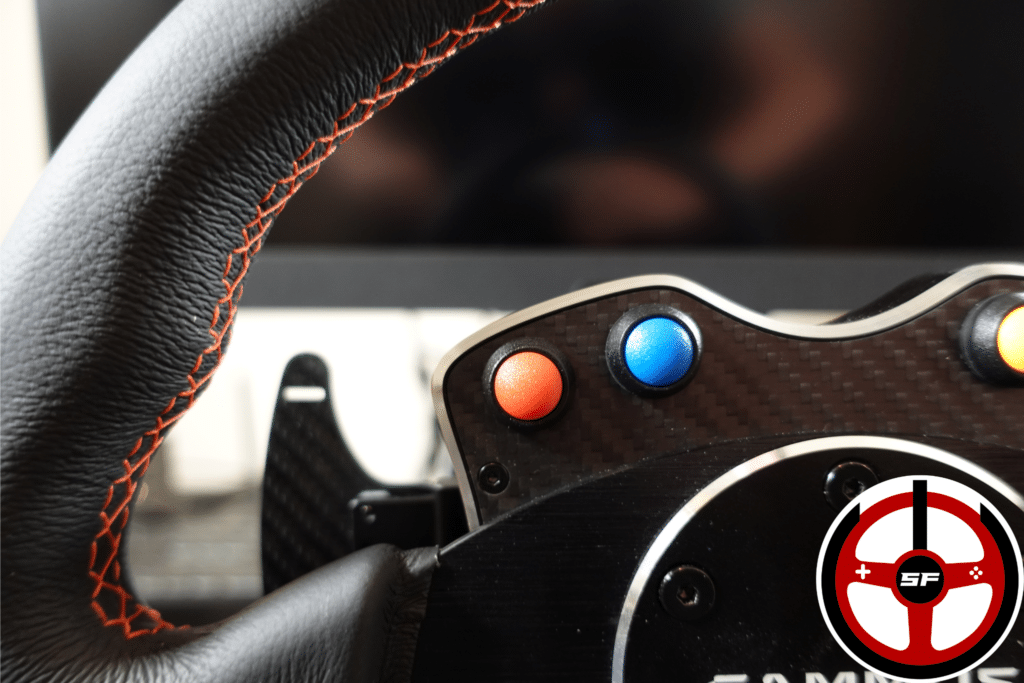
As for the functions on the steering wheel and base unit, here again the assessment is very mixed. The buttons are, as I said earlier, very soft and give no feedback when activated, apart from their light, which is hidden by the finger.
The magnetic paddles are pleasant, perhaps a little noisy, but nothing to worry about, especially at this price level.
The buttons on the base are difficult to use during a race, as they are not easily accessible. On the other hand, they can be used for functions that are rarely used, such as changing the view or switching on the vehicle’s ignition. In other words, they’re there, so let’s make the most of them!
The rotary selectors, on the other hand, should really be changed by the brand. They’re VERY inaccurate. You never know whether turning a notch will make the selector work or not. So it’s useless for adjusting Traction Control or ABS effectively several times per lap during a race.
Forget central heating!
A final point to highlight is the heating of this Cammus DDWB base. The fan at the rear of the base was well used during these tests, to say the least. Surprisingly, however, the heat wasn’t as intense on all simus.
On Assetto Corsa, I had no trouble warming up the base in 3 to 4 minutes on oval tracks. But surprisingly, the same circuits with the same force in other simus didn’t heat up the engine as much.
Why certain combos made the base heat up so fast and hard remains a mystery to me, but I’ll let you know if I find the answer.

